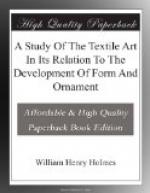[Illustration: FIG. 339. Conventional figures from a California Indian basket.]
[Illustration: FIG. 340. Basket made by the Yokut Indians of California.]
Turning southward from California and passing through many strange lands we find ourselves in Peru, and among a class of remains that bespeak a high grade of culture. The inhabitants of Ancon were wonderfully skilled in the textile art, and thousands of handsome examples have been obtained from their ancient tombs. Among these relics are many neat little workbaskets woven from rushes. One of these, now in the National Museum, is encircled by a decorated belt in which are represented seven human figures woven in black filaments upon a brown ground.
The base and rim of the basket are woven in the intertwined combination, but in the decorated belt the style is changed to the plain right angled interlacing, for the reason, no doubt, that this combination was better suited to the development of the intended design. Besides the fundamental series of fillets the weaver resorted to unusual devices in order to secure certain desired results. In the first place the black horizontal series of filaments does not alternate in the simplest way with the brown series, but, where a wide space of the dark color is called for, several of the brown strands are passed over at one step, as in the head and body, and in the wider interspaces the dark strands pass under two or more of the opposing strands. In this way broad areas of color are obtained. It will be observed, however, that the construction is weakened by this modification, and that to remedy the defect two additional extra constructive series of fillets are added. These are of much lighter weight than the main series, that they may not obscure the pattern. Over the dark series they run vertically and over the light obliquely.
[Illustration: FIG. 341. Conventional human figures from an ancient Peruvian basket.]
It will be seen that the result, notwithstanding all this modification of procedure, is still remarkably like that of the preceding examples, the figures corresponding closely in kind and degree of geometricity.
The fact is that in this coarse work refinement of drawing is absolutely unattainable. It appears that the sharply pronounced steps exhibited in the outlines are due to the great width of the fillets used. With the finer threads employed by most nations of moderate culture the stepped effect need not obtrude itself, for smooth outlines and graceful curves are easily attainable; yet, as a rule, even the finer fabrics continue to exhibit in their decorations the pronounced geometric character seen in ruder forms. I present a striking example of this in Fig. 342, a superb piece of Incarian gobelins, in which a gaily costumed personage is worked upon a dark red ground dotted with symbols and strange devices. The work is executed in brilliant colors and in great detail. But with all the facility afforded for the expression of minutely modulated form the straight lines and sharp angles are still present. The traditions of the art were favorable to great geometricity, and the tendencies of the warp and woof and the shape of the spaces to be filled were decidedly in that direction.




